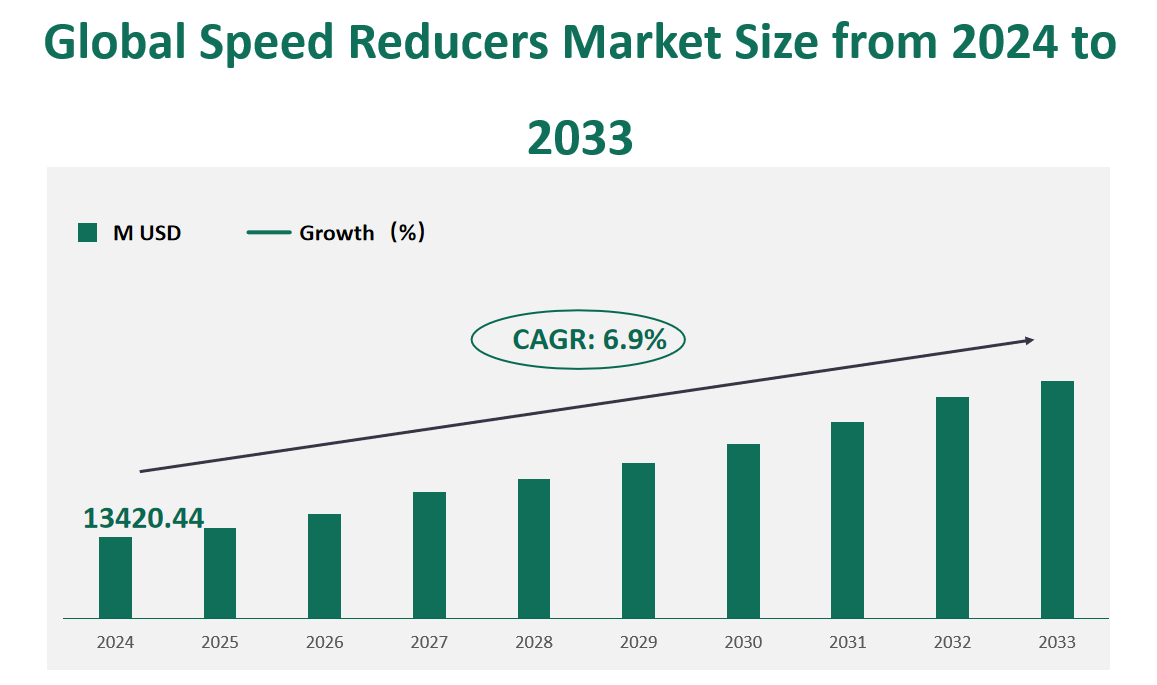1 Global Speed Reducers Market Insight Analysis
The global Speed Reducers Market is expected to reach a total value of US$13420.44 million in 2024. The CAGR from 2024 to 2033 is expected to be approximately 6.9%.
Speed Reducers are the devices that slow down the torque of a motor by transporting power from less teethed gear too high in number teethed gear.
Figure Global Speed Reducers Market Size (M USD) and CAGR (2024-2033)

2 Speed Reducers Market Growth Drivers and Restraints
The global speed reducer market is influenced by a variety of factors that either drive its growth or pose challenges to its expansion. One of the main drivers is the growing demand from numerous downstream industries, including robotics, renewable energy, and high-end machinery. As these industries continue to grow, the need for reliable and efficient speed reducers becomes more evident, leading to a surge in market demand.
The advent of Industry 4.0 has ushered in a new era of intelligent digital technology integration into manufacturing and industrial processes. As these technologies become more prevalent in the global market, the demand for speed reducers from industrial automation equipment and robots has also increased. The aging of the global population and the resulting rise in labor costs have made industrial automation and robotics increasingly attractive, further driving the development of the speed reducer market.
Another important driver is the continuous breakthrough in product technology. Innovations in materials and processing technology have led to improvements in the quality and performance of speed reducers. This not only increases the added value of the product, but also directly improves the profitability of manufacturers, promoting the healthy and rapid development of the industry.
However, the market is not without challenges. Intensified market competition is a major constraint, as the growing demand for speed reducers attracts more players to enter the market. This competition can lead to aggressive market strategies, including price wars, which can affect profitability. In addition, the relative shortage of compound talents or multidisciplinary experts is also a limiting factor. The industry requires a workforce with a high theoretical foundation and technical skills, which is a challenge given the professionalism of the field.
Technology and capital barriers also limit the growth of the market. The reducer industry is interdisciplinary, involving technologies such as metal materials, heat treatment, and gear quenching. New entrants face significant technical challenges, including design and process technology capabilities. In addition, the capital-intensive nature of the industry means that new players must make a large initial investment in fixed assets, which can be a barrier. The need for advanced processing and testing equipment to meet the high quality and high precision requirements of downstream customers also poses financial challenges.
3 Technological Innovations and Mergers in the Speed Reducers Market
Technological innovation plays a key role in shaping the global speed reducer market. The integration of IoT technology with speed reducers is a game changer, enabling real-time monitoring and control through smart speed reducers equipped with sensors and connectivity options. The technology facilitates predictive maintenance, which can identify and resolve potential issues before they lead to downtime, thereby saving costs and improving reliability.
The market has also witnessed significant advancements in material science, with manufacturers investigating and adopting advanced alloys and composite materials to extend the life and functionality of speed reducers. This is in line with the industry’s focus on durable yet lightweight components and enhanced torque capabilities. The global shift towards renewable energy sources such as wind and solar energy has created new growth avenues for speed reducers, which are essential for wind turbines to regulate the speed of the generator to match the wind speed.
In terms of corporate activities, mergers and acquisitions have played a major role in reshaping the competitive landscape of the speed reducer market. The most notable of these was the Carlyle Group’s acquisition of Flender from Siemens AG for EUR 2 billion, which highlights the strategic importance of speed reducers in the field of electromechanical drive technology. Such integrations enable companies to expand their product portfolios, increase market coverage, and create shareholder value through increased growth and significant cost synergies.
In addition, companies like Nidec are investing heavily in expanding manufacturing facilities to lead strain wave gears, aiming to double sales and surpass current market leaders. These strategic moves demonstrate the intensity of competition and the pursuit of market leadership through innovation and expansion.
In summary, the global speed reducer market is driven by technological advancements, growing demand across industries, and the integration of smart technologies. However, it also faces challenges such as market competition, talent shortages, and high barriers to entry. Another feature of the market evolution is active mergers and acquisitions, which are shaping the competitive landscape and driving industry consolidation.
4 Global Speed Reducers Market Size by Type
Gear Reducer: This type of speed reducer, known for its efficiency in transferring high torque at lower speeds, is expected to generate a revenue of $4,835.21 million in 2024. Accounting for a substantial market share, gear reducers are projected to hold 36.03% of the total market share, reflecting their widespread use in various industries due to their reliability and efficiency.
Worm Wheel Reducer: With a forecasted revenue of $2,725.13 million, worm wheel reducers are anticipated to capture 20.31% of the market share. These reducers are valued for their self-locking feature, which is beneficial in applications requiring precise control and safety mechanisms.
Planetary Gears: Generating a revenue of $2,083.17 million, planetary gears are projected to have a 15.52% share of the market. These reducers are recognized for their compact design and high load-bearing capacity, making them ideal for applications where space is limited and high torque is required.
Cycloid Reducer: Expected to bring in $3,036.47 million in revenue, cycloid reducers are forecasted to hold 22.63% of the market share. Known for their high efficiency and low noise operation, cycloid reducers are preferred in applications where smooth operation is critical.
Harmonic Drive: With a forecasted revenue of $740.46 million, harmonic drives are expected to account for 5.52% of the market share. These reducers are valued for their precision and high reduction ratios, making them indispensable in high-precision applications such as robotics and aerospace.
Table Global Speed Reducers Market Size and Share by Type in 2024
|
Type |
Market Size (M USD) 2024 |
Market Share 2024 |
|---|---|---|
|
Gear Reducer |
4835.21 |
36.03% |
|
Worm Wheel Reducer |
2725.13 |
20.31% |
|
Planetary Gears |
2083.17 |
15.52% |
|
Cycloid Reducer |
3036.47 |
22.63% |
|
Harmonic Drive |
740.46 |
5.52% |
5 Global Speed Reducers Market Size by Application
Automotive Industry: With a forecasted revenue of $1,215.06 million, the automotive industry is expected to account for 9.05% of the total market share. Speed reducers in this sector are crucial for controlling vehicle speed and torque, ensuring smooth operation and improved performance.
Industrial: The industrial application is projected to generate the highest revenue, with a forecast of $12,205.38 million, capturing 90.95% of the market share. This segment includes a wide range of uses, from material handling to heavy machinery, where speed reducers are essential for efficient operation and precise control.
The automotive industry’s reliance on speed reducers is primarily due to the increasing demand for advanced transmission systems and the growing electric vehicle market. On the other hand, the industrial sector’s dominance is attributed to the broad application of speed reducers in various machinery and equipment that require precise speed control and torque adjustment.
Table Global Speed Reducers Market Size and Share by Application in 2024
|
Application |
Market Size (M USD) 2024 |
Market Share 2024 |
|---|---|---|
|
Automotive Industry |
1215.06 |
9.05% |
|
Industrial |
12205.38 |
90.95% |
6 Global Speed Reducers Market Size by Region
North America: Expected to generate a revenue of $2,763.74 million. The region’s strong manufacturing base and technological advancements contribute significantly to the market’s growth.
Europe: With a forecasted revenue of $2,992.09 million. The region’s focus on industrial automation and advanced manufacturing drives the demand for speed reducers.
Asia Pacific: This region is expected to lead the market with a revenue of $7,106.41 million. The rapid industrialization and growth of the manufacturing sector in countries like China and India are key factors contributing to this region’s dominance.
Latin America: Projected to generate $314.46 million in revenue. The region’s market is growing, albeit at a slower pace, due to increasing industrial activities.
Middle East and Africa: With a forecasted revenue of $243.74 million. The market in this region is influenced by the growth of the oil and gas industry, which requires speed reducers for various applications.
The regional analysis reveals that Asia Pacific and Europe are the leading contributors to the global speed reducers market, driven by their strong industrial bases and technological advancements. North America follows closely, with a significant market share. Latin America and the Middle East and Africa, while smaller in market share, show potential for growth due to increasing industrial activities and investments in infrastructure development.
Figure Global Speed Reducers Market Size (M USD) by Region in 2024

7 Global Speed Reducers Market Analysis by Major Players
7.1 Sew eurodrive
Company Introduction and Business Overview:
Sew-eurodrive, established in 1931 and headquartered in Germany, is a leading provider of industrial automation products with a global market distribution across the Americas, Europe, and Asia.
The company specializes in the design, development, and sales of gear units, motors, communication modules, inverters, controllers, industrial software, and more. Sew-eurodrive caters to industries such as automotive, logistics, food, and tire, offering a comprehensive suite of solutions for industrial automation.
Products:
Known for its planetary gear units PPK series, these gearboxes are designed for heavy-duty applications requiring robust design, high transmission ratios, and compactness.
Market Performance in 2024:
In 2024, Sew-eurodrive achieved a revenue of $726.67 million with a gross margin of 31.32%.
7.2 Flender
Company Introduction and Business Overview:
Flender, founded in 1899 and based in Germany, is a global leader in mechanical and electrical drive technology with a presence in the Americas, Europe, and Asia.
Flender GmbH offers a comprehensive product and service portfolio, including custom-made gear units, couplings, add-on parts, air-cooled condensers, belt conveyors, and gear units for drive systems.
Products:
The company’s PLANUREX gear units for traveling gears are compact, powerful, and equipped with an optimized sealing system for extreme operating conditions.
Market Performance in 2024:
Flender reported a revenue of $420.27 million in 2024, with a gross margin of 30.66%.
7.3 HDSI
Company Introduction and Business Overview:
HDSI, established in 1970 and headquartered in Japan, is a major player in the speed reducers market with a market distribution focused on North America, Europe, and Asia.
HDSI manufactures and sells high-precision reduction gears under the Harmonic Drive brand, as well as other mechatronics products such as rotary actuators, linear actuators, and AC servo motors.
Products:
The company’s Harmonic Drive® is a speed reducer known for its compact design, high torque, and high accuracy, used across a wide range of applications.
Market Performance in 2024:
HDSI achieved a revenue of $432.28 million in 2024, with an impressive gross margin of 62.37%.





